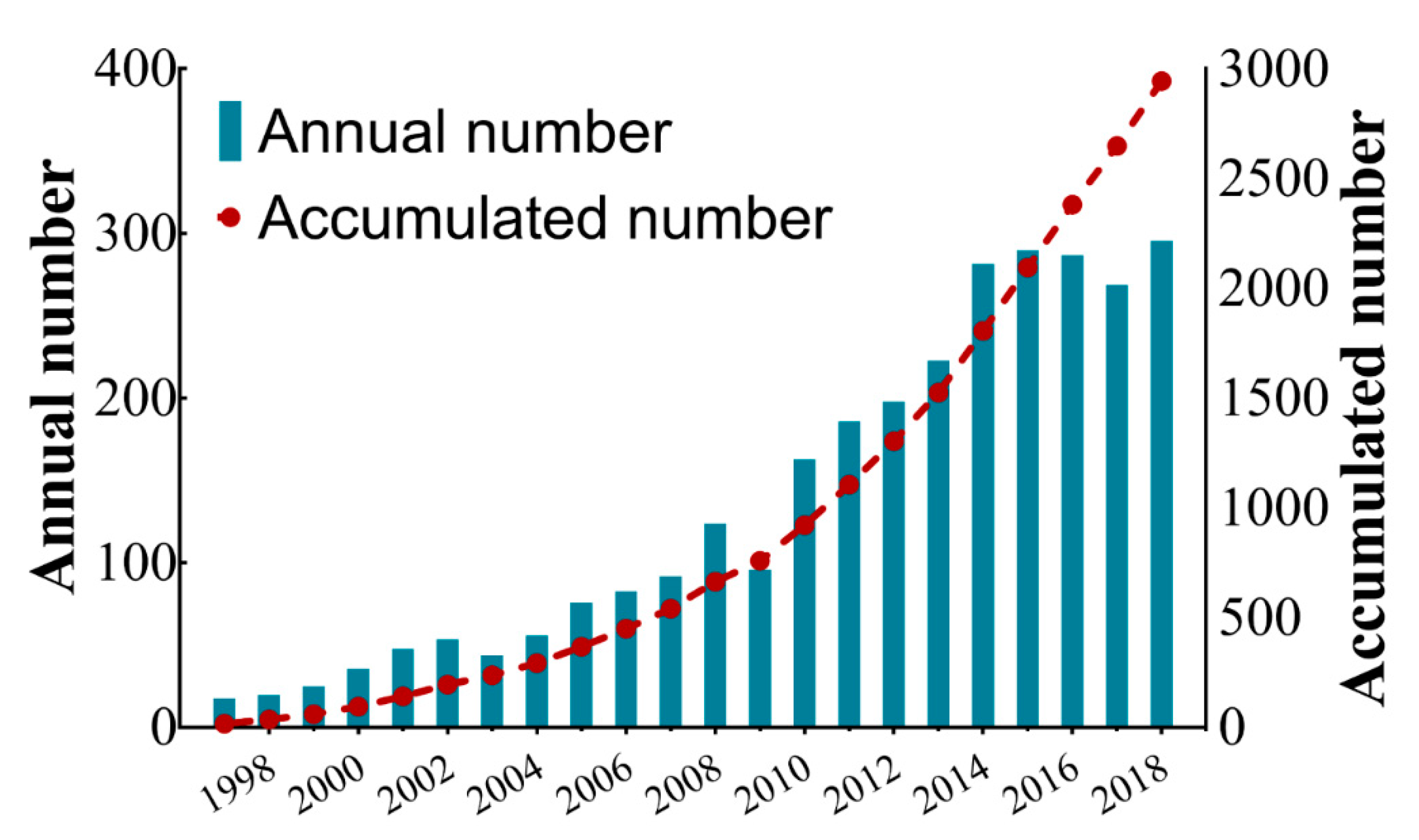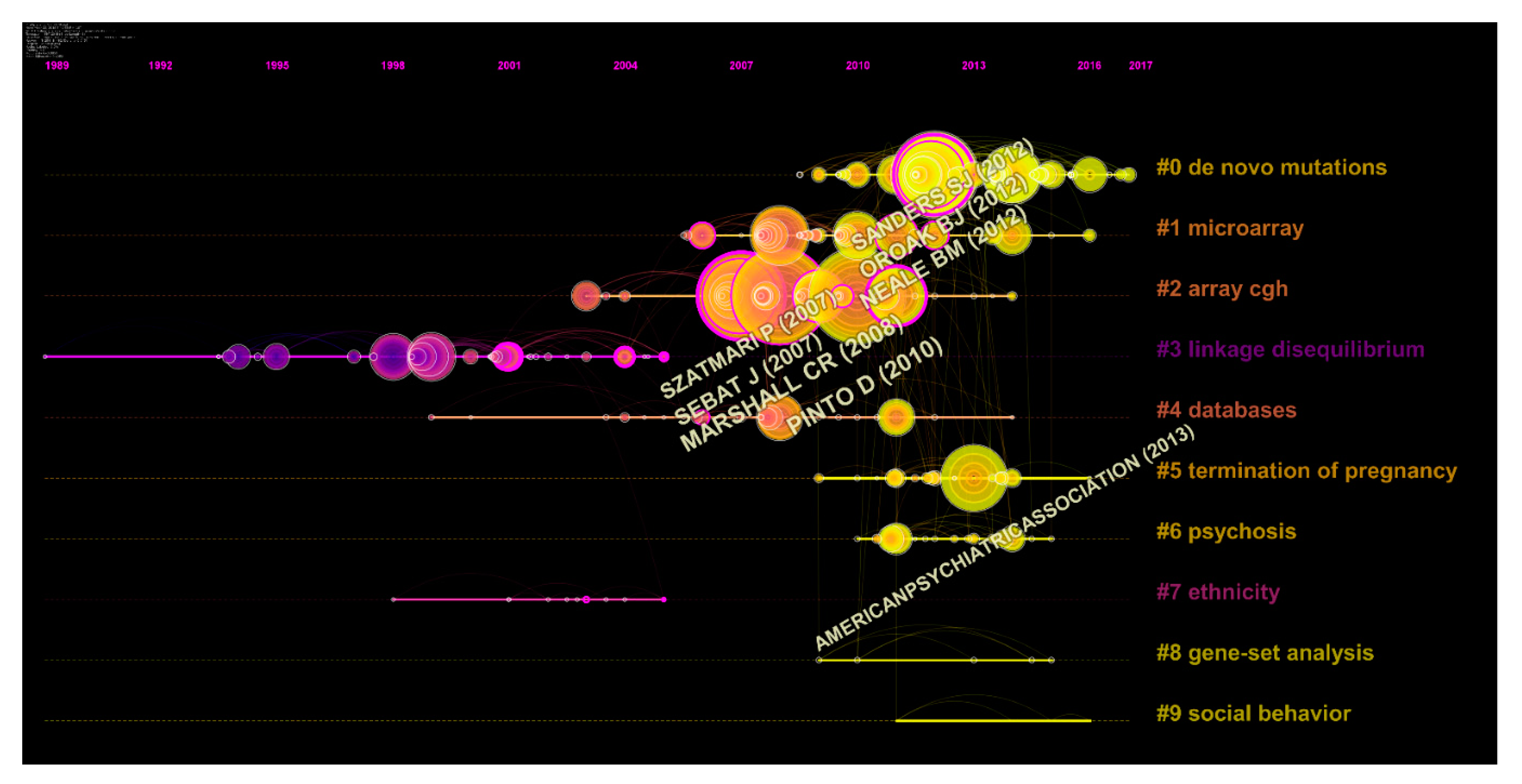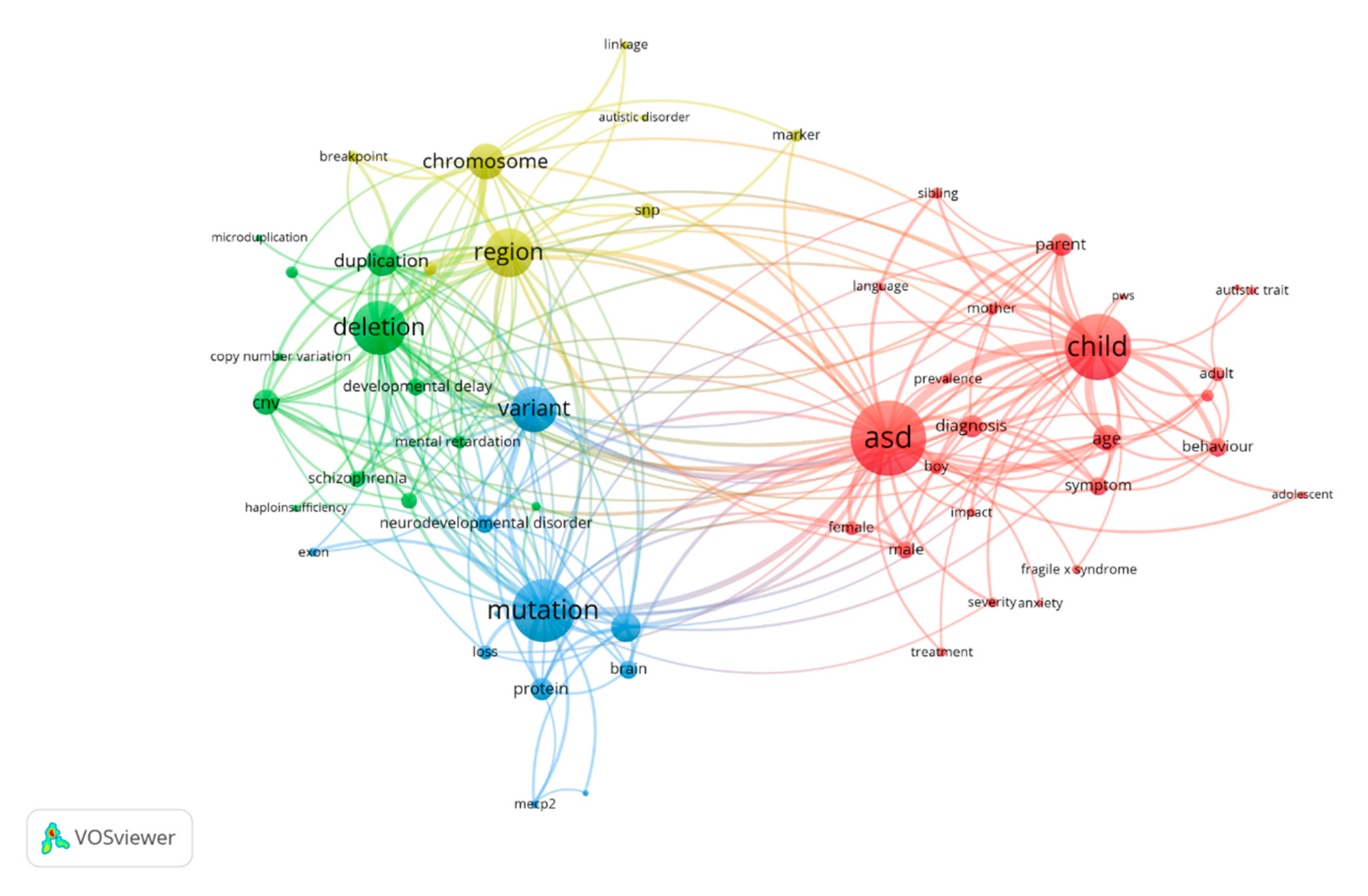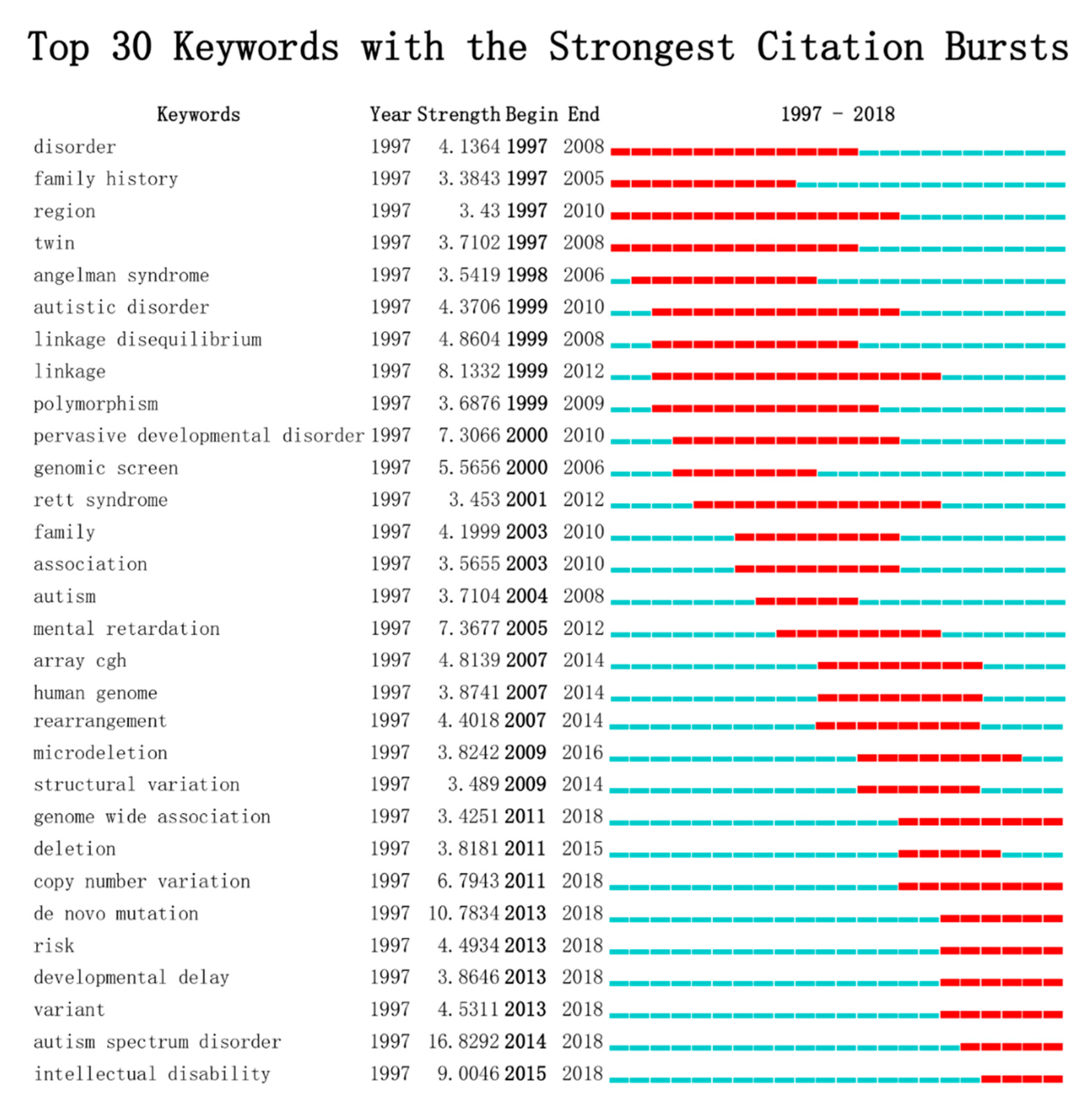A Bibliometric Insight of Genetic Factors in ASD: Emerging Trends and New Developments
Abstract
:1. Introduction
2. Materials and Methods
3. Results
3.1. Analysis of Quantity and Growth Trend of Annual Publications
3.2. Leading Countries and Institutions
3.3. Most Active Journals and Highly Cited Publications
3.4. Development Skeleton and Scientific Landscapes of Genetic Factors in Autism
3.5. Visualization Analysis of Focus Transfer and Research Frontiers
4. Discussion
5. Conclusions
6. Limitations
Author Contributions
Funding
Data Availability Statement
Acknowledgments
Conflicts of Interest
References
- Association, A.P. Diagnostic and Statistical Manual of Mental Disorders (DSM-5®); American Psychiatric Pub: Washington, DC, USA, 2013; ISBN 0-89042-557-4. [Google Scholar]
- Lai, M.-C.; Lombardo, M.V.; Baron-Cohen, S. Autism. Lancet 2014, 383, 896–910. [Google Scholar] [CrossRef]
- Grove, J.; Ripke, S.; Als, T.D.; Mattheisen, M.; Walters, R.K.; Won, H.; Pallesen, J.; Agerbo, E.; Andreassen, O.A.; Anney, R.; et al. Identification of common genetic risk variants for autism spectrum disorder. Nat. Genet. 2019, 51, 431–444. [Google Scholar] [CrossRef] [PubMed] [Green Version]
- Parish, S.; Thomas, K.; Rose, R.; Kilany, M.; McConville, R. State Insurance Parity Legislation for Autism Services and Family Financial Burden. Intellect. Dev. Disabil. 2012, 50, 190–198. [Google Scholar] [CrossRef] [PubMed]
- Zablotsky, B.; Kalb, L.G.; Freedman, B.; Vasa, R.; Stuart, E.A. Health Care Experiences and Perceived Financial Impact among Families of Children with an Autism Spectrum Disorder. Psychiatr. Serv. 2014, 65, 395–398. [Google Scholar] [CrossRef] [PubMed] [Green Version]
- Murray, C.J.L.; Ezzati, M.; Flaxman, A.D.; Lim, S.; Lozano, R.; Michaud, C.; Naghavi, M.; Salomon, J.A.; Shibuya, K.; Vos, T.; et al. GBD 2010: Design, definitions, and metrics. Lancet 2012, 380, 2063–2066. [Google Scholar] [CrossRef]
- Baxter, A.J.; Brugha, T.S.; Erskine, H.E.; Scheurer, R.W.; Vos, T.; Scott, J.G. The epidemiology and global burden of autism spectrum disorders. Psychol. Med. 2015, 45, 601–613. [Google Scholar] [CrossRef]
- Buescher, A.V.S.; Cidav, Z.; Knapp, M.; Mandell, D.S. Costs of Autism Spectrum Disorders in the United Kingdom and the United States. JAMA Pediatr. 2014, 168, 721–728. [Google Scholar] [CrossRef]
- Sahin, M.; Sur, M. Genes, circuits, and precision therapies for autism and related neurodevelopmental disorders. Science 2015, 350. [Google Scholar] [CrossRef] [Green Version]
- Onore, C.; Careaga, M.; Ashwood, P. The role of immune dysfunction in the pathophysiology of autism. Brain Behav. Immun. 2012, 26, 383–392. [Google Scholar] [CrossRef] [Green Version]
- Bibel, B.M. Autism & Diet: What You Need To Know. Libr. J. 2009, 134, 95. [Google Scholar]
- Hallmayer, J.; Cleveland, S.; Torres, A.; Phillips, J.; Cohen, B.; Torigoe, T.; Miller, J.; Fedele, A.; Collins, J.; Smith, K.; et al. Genetic heritability and shared environmental factors among twin pairs with autism. Arch. Gen. Psychiatry 2011, 68, 1095–1102. [Google Scholar] [CrossRef] [PubMed]
- Van Loo, K.M.J.; Martens, G.J.M. Genetic and environmental factors in complex neurodevelopmental disorders. Curr. Genom. 2007, 8, 429–444. [Google Scholar] [CrossRef] [Green Version]
- Ronald, A.; Hoekstra, R.A. Autism spectrum disorders and autistic traits: A decade of new twin studies. Am. J. Med. Genet. B Neuropsychiatr. Genet. 2011, 156, 255–274. [Google Scholar] [CrossRef] [PubMed]
- Murdoch, J.D.; State, M.W. Recent developments in the genetics of autism spectrum disorders. Curr. Opin. Genet. Dev. 2013, 23, 310–315. [Google Scholar] [CrossRef]
- Stessman, H.A.F.; Xiong, B.; Coe, B.P.; Wang, T.; Hoekzema, K.; Fenckova, M.; Kvarnung, M.; Gerdts, J.; Trinh, S.; Cosemans, N.; et al. Targeted sequencing identifies 91 neurodevelopmental-disorder risk genes with autism and developmental-disability biases. Nat. Genet. 2017, 49, 515–526. [Google Scholar] [CrossRef]
- Bernier, R.; Golzio, C.; Xiong, B.; Stessman, H.A.; Coe, B.P.; Penn, O.; Witherspoon, K.; Gerdts, J.; Baker, C.; Vulto-van Silfhout, A.T.; et al. Disruptive CHD8 mutations define a subtype of autism early in development. Cell 2014, 158, 263–276. [Google Scholar] [CrossRef] [Green Version]
- Budimirovic, D.B.; Schlageter, A.; Filipovic-Sadic, S.; Protic, D.D.; Bram, E.; Mahone, E.M.; Nicholson, K.; Culp, K.; Javanmardi, K.; Kemppainen, J.; et al. A Genotype-Phenotype Study of High-Resolution FMR1 Nucleic Acid and Protein Analyses in Fragile X Patients with Neurobehavioral Assessments. Brain Sci. 2020, 10, 694. [Google Scholar] [CrossRef]
- Zupic, I.; Cater, T. Bibliometric Methods in Management and Organization. Organ. Res. Methods 2015, 18, 429–472. [Google Scholar] [CrossRef]
- Zyoud, S.H.; Waring, W.S.; Al-Jabi, S.W.; Sweileh, W.M. Bibliometric profile of global scientific research on digoxin toxicity (1849–2015). Drug Chem. Toxicol. 2018, 1–7. [Google Scholar] [CrossRef]
- Kamdem, J.P.; Duarte, A.E.; Rodrigues Lima, K.R.; Teixeira Rocha, J.B.; Hassan, W.; Barros, L.M.; Roeder, T.; Tsopmo, A. Research trends in food chemistry: A bibliometric review of its 40 years anniversary (1976–2016). Food Chem. 2019, 294, 448–457. [Google Scholar] [CrossRef]
- Van Eck, N.J.; Waltman, L. Visualizing Bibliometric Networks. In Measuring Scholarly Impact: Methods and Practice; Ding, Y., Rousseau, R., Wolfram, D., Eds.; Springer International Publishing: Cham, Switzerland, 2014; pp. 285–320. ISBN 978-3-319-10377-8. [Google Scholar]
- Perianes-Rodriguez, A.; Waltman, L.; van Eck, N.J. Constructing bibliometric networks: A comparison between full and fractional counting. J. Informetr. 2016, 10, 1178–1195. [Google Scholar] [CrossRef] [Green Version]
- Chen, C. Searching for intellectual turning points: Progressive knowledge domain visualization. Proc. Natl. Acad. Sci. USA 2004, 101, 5303–5310. [Google Scholar] [CrossRef] [PubMed] [Green Version]
- Chen, C. CiteSpace II: Detecting and visualizing emerging trends and transient patterns in scientific literature. J. Am. Soc. Inf. Sci. Technol. 2006, 57, 359–377. [Google Scholar] [CrossRef] [Green Version]
- Brookes, B.C. Bradford’s law and the bibliography of science. Nature 1969, 224, 953–956. [Google Scholar] [CrossRef] [PubMed]
- Desai, N.; Veras, L.; Gosain, A. Using Bradford’s law of scattering to identify the core journals of pediatric surgery. J. Surg. Res. 2018, 229, 90–95. [Google Scholar] [CrossRef] [PubMed]
- Amir, R.E.; Van den Veyver, I.B.; Wan, M.; Tran, C.Q.; Francke, U.; Zoghbi, H.Y. Rett Syndrome Is Caused by Mutations in X-Linked MECP2, Encoding Methyl-CpG-Binding Protein 2. Nat. Genet. 1999, 23, 185–188. [Google Scholar] [CrossRef]
- Kircher, M.; Witten, D.M.; Jain, P.; O’Roak, B.J.; Cooper, G.M.; Shendure, J. A General Framework for Estimating the Relative Pathogenicity of Human Genetic Variants. Nat. Genet. 2014, 46, 310–315. [Google Scholar] [CrossRef] [Green Version]
- Miller, D.T.; Adam, M.P.; Aradhya, S.; Biesecker, L.G.; Brothman, A.R.; Carter, N.P.; Church, D.M.; Crolla, J.A.; Eichler, E.E.; Epstein, C.J.; et al. Consensus Statement: Chromosomal Microarray Is a First-Tier Clinical Diagnostic Test for Individuals with Developmental Disabilities or Congenital Anomalies. Am. J. Hum. Genet. 2010, 86, 749–764. [Google Scholar] [CrossRef]
- Marshall, C.R.; Noor, A.; Vincent, J.B.; Lionel, A.C.; Feuk, L.; Skaug, J.; Shago, M.; Moessner, R.; Pinto, D.; Ren, Y.; et al. Structural Variation of Chromosomes in Autism Spectrum Disorder. Am. J. Hum. Genet. 2008, 82, 477–488. [Google Scholar] [CrossRef] [Green Version]
- Jamain, S.; Quach, H.; Betancur, C.; Råstam, M.; Colineaux, C.; Gillberg, I.C.; Soderstrom, H.; Giros, B.; Leboyer, M.; Gillberg, C.; et al. Mutations of the X-Linked Genes Encoding Neuroligins NLGN3 and NLGN4 Are Associated with Autism. Nat. Genet. 2003, 34, 27–29. [Google Scholar] [CrossRef] [Green Version]
- Cross-Disorder Group of the Psychiatric Genomics Consortium; Lee, S.H.; Ripke, S.; Neale, B.M.; Faraone, S.V.; Purcell, S.M.; Perlis, R.H.; Mowry, B.J.; Thapar, A.; Goddard, M.E.; et al. Genetic Relationship between Five Psychiatric Disorders Estimated from Genome-Wide SNPs. Nat. Genet. 2013, 45, 984–994. [Google Scholar] [CrossRef] [PubMed] [Green Version]
- Autism Genome Project Consortium; Szatmari, P.; Paterson, A.D.; Zwaigenbaum, L.; Roberts, W.; Brian, J.; Liu, X.-Q.; Vincent, J.B.; Skaug, J.L.; Thompson, A.P.; et al. Mapping Autism Risk Loci Using Genetic Linkage and Chromosomal Rearrangements. Nat. Genet. 2007, 39, 319–328. [Google Scholar] [CrossRef] [PubMed] [Green Version]
- Durand, C.M.; Betancur, C.; Boeckers, T.M.; Bockmann, J.; Chaste, P.; Fauchereau, F.; Nygren, G.; Rastam, M.; Gillberg, I.C.; Anckarsäter, H.; et al. Mutations in the Gene Encoding the Synaptic Scaffolding Protein SHANK3 Are Associated with Autism Spectrum Disorders. Nat. Genet. 2007, 39, 25–27. [Google Scholar] [CrossRef] [PubMed] [Green Version]
- Cooper, G.M.; Coe, B.P.; Girirajan, S.; Rosenfeld, J.A.; Vu, T.H.; Baker, C.; Williams, C.; Stalker, H.; Hamid, R.; Hannig, V.; et al. A Copy Number Variation Morbidity Map of Developmental Delay. Nat. Genet. 2011, 43, 838–846. [Google Scholar] [CrossRef] [Green Version]
- O’Roak, B.J.; Deriziotis, P.; Lee, C.; Vives, L.; Schwartz, J.J.; Girirajan, S.; Karakoc, E.; Mackenzie, A.P.; Ng, S.B.; Baker, C.; et al. Exome Sequencing in Sporadic Autism Spectrum Disorders Identifies Severe de Novo Mutations. Nat. Genet. 2011, 43, 585–589. [Google Scholar] [CrossRef]
- Small, H. Co-citation in the scientific literature: A new measure of the relationship between two documents. J. Am. Soc. Inf. Sci. 1973, 42, 676–684. [Google Scholar] [CrossRef]
- Belinchón Carmona, M.; Boada Muñoz, L.; García de Andrés, E.; Fuentes Biggi, J.; Posada de la Paz, M. Trends in studies on autism in Spain: Publications and authorship networks (1974–2007). Psicothema 2010, 22, 242–249. [Google Scholar]
- Teixeira, M.C.T.V.; Mecca, T.P.; Velloso, R.D.L.; Bravo, R.B.; Ribeiro, S.H.B. Brazilian scientific output on autism spectrum disorders. Rev. Assoc. Med. Bras. (1992) 2010, 56, 607–614. [Google Scholar] [CrossRef] [Green Version]
- Whyatt, C.P.; Torres, E.B. Autism Research: An Objective Quantitative Review of Progress and Focus between 1994 and 2015. Front. Psychol. 2018, 9, 1526. [Google Scholar] [CrossRef]
- Sweileh, W.M.; Al-Jabi, S.W.; Sawalha, A.F.; Zyoud, S.H. Bibliometric profile of the global scientific research on autism spectrum disorders. Springerplus 2016, 5, 1480. [Google Scholar] [CrossRef] [Green Version]
- Lei, G.; Liu, F.; Liu, P.; Zhou, Y.; Jiao, T.; Dang, Y.-H. Worldwide tendency and focused research in forensic anthropology: A bibliometric analysis of decade (2008–2017). Leg. Med. 2019, 37, 67–75. [Google Scholar] [CrossRef] [PubMed]
- Liao, H.; Tang, M.; Luo, L.; Li, C.; Chiclana, F.; Zeng, X.-J. A Bibliometric Analysis and Visualization of Medical Big Data Research. Sustainability 2018, 10, 166. [Google Scholar] [CrossRef] [Green Version]
- Cai, X.; Zhou, C.; Zhou, L.; Xu, Q. A bibliometric analysis of IL-35 research from 2009 to 2018. PeerJ 2019, 7, e7992. [Google Scholar] [CrossRef] [PubMed]
- Devos, P.; Menard, J. Bibliometric analysis of research relating to hypertension reported over the period 1997–2016. J. Hypertens. 2019, 37, 2116–2122. [Google Scholar] [CrossRef] [Green Version]
- Van Heyningen, V. Genome sequencing-the dawn of a game-changing era. Heredity 2019, 123, 58–66. [Google Scholar] [CrossRef]
- Matuszek, G.; Talebizadeh, Z. Autism genetic database (AGD): A comprehensive database including autism susceptibility gene-CNVs integrated with known noncoding RNAs and fragile sites. BMC Med. Genet. 2009, 10, 102. [Google Scholar] [CrossRef] [Green Version]
- Fischbach, G.D.; Lord, C. The Simons Simplex Collection: A Resource for Identification of Autism Genetic Risk Factors. Neuron 2010, 68, 192–195. [Google Scholar] [CrossRef] [Green Version]
- Yuen, R.K.C.; Merico, D.; Bookman, M.; Howe, J.L.; Thiruvahindrapuram, B.; Patel, R.V.; Whitney, J.; Deflaux, N.; Bingham, J.; Wang, Z.; et al. Whole genome sequencing resource identifies 18 new candidate genes for autism spectrum disorder. Nat. Neurosci. 2017, 20, 602–611. [Google Scholar] [CrossRef]
- Weiss, L.A.; Shen, Y.; Korn, J.M.; Arking, D.E.; Miller, D.T.; Fossdal, R.; Saemundsen, E.; Stefansson, H.; Ferreira, M.A.R.; Green, T.; et al. Association between microdeletion and microduplication at 16p11.2 and autism. N. Engl. J. Med. 2008, 358, 667–675. [Google Scholar] [CrossRef] [Green Version]
- Pinto, D.; Pagnamenta, A.T.; Klei, L.; Anney, R.; Merico, D.; Regan, R.; Conroy, J.; Magalhaes, T.R.; Correia, C.; Abrahams, B.S.; et al. Functional impact of global rare copy number variation in autism spectrum disorders. Nature 2010, 466, 368–372. [Google Scholar] [CrossRef] [Green Version]
- Sebat, J.; Lakshmi, B.; Malhotra, D.; Troge, J.; Lese-Martin, C.; Walsh, T.; Yamrom, B.; Yoon, S.; Krasnitz, A.; Kendall, J.; et al. Strong association of de novo copy number mutations with autism. Science 2007, 316, 445–449. [Google Scholar] [CrossRef] [PubMed] [Green Version]
- Sanders, S.J.; Murtha, M.T.; Gupta, A.R.; Murdoch, J.D.; Raubeson, M.J.; Willsey, A.J.; Ercan-Sencicek, A.G.; DiLullo, N.M.; Parikshak, N.N.; Stein, J.L.; et al. De novo mutations revealed by whole-exome sequencing are strongly associated with autism. Nature 2012, 485, 237–241. [Google Scholar] [CrossRef] [PubMed]
- O’Roak, B.J.; Vives, L.; Fu, W.; Egertson, J.D.; Stanaway, I.B.; Phelps, I.G.; Carvill, G.; Kumar, A.; Lee, C.; Ankenman, K.; et al. Multiplex targeted sequencing identifies recurrently mutated genes in autism spectrum disorders. Science 2012, 338, 1619–1622. [Google Scholar] [CrossRef] [Green Version]
- Drakesmith, M.; Parker, G.D.; Smith, J.; Linden, S.C.; Rees, E.; Williams, N.; Owen, M.J.; van den Bree, M.; Hall, J.; Jones, D.K.; et al. Genetic risk for schizophrenia and developmental delay is associated with shape and microstructure of midline white-matter structures. Transl. Psychiatry 2019, 9, 102. [Google Scholar] [CrossRef] [PubMed] [Green Version]
- Marshall, C.R.; Howrigan, D.P.; Merico, D.; Thiruvahindrapuram, B.; Wu, W.; Greer, D.S.; Antaki, D.; Shetty, A.; Holmans, P.A.; Pinto, D.; et al. Contribution of copy number variants to schizophrenia from a genome-wide study of 41,321 subjects. Nat. Genet. 2017, 49, 27–35. [Google Scholar] [CrossRef] [Green Version]
- DeSanto, C.; D’Aco, K.; Araujo, G.C.; Shannon, N.; Study, D.; Vernon, H.; Rahrig, A.; Monaghan, K.G.; Niu, Z.; Vitazka, P.; et al. WAC loss-of-function mutations cause a recognisable syndrome characterised by dysmorphic features, developmental delay and hypotonia and recapitulate 10p11.23 microdeletion syndrome. J. Med. Genet. 2015, 52, 754–761. [Google Scholar] [CrossRef]
- Deciphering Developmental Disorders Study. Large-scale discovery of novel genetic causes of developmental disorders. Nature 2015, 519, 223–228. [Google Scholar] [CrossRef]
- Santangelo, S.L.; Tsatsanis, K. What is known about autism—Genes, brain, and behavior. Am. J. Pharm. 2005, 5, 71–92. [Google Scholar] [CrossRef]
- Barki, H.; Rivard, S.; Talbot, J. A Keyword Classification Scheme for Is Research Literature—An Update. MIS Q. 1993, 17, 209–226. [Google Scholar] [CrossRef]
- Alonso-Gonzalez, A.; Rodriguez-Fontenla, C.; Carracedo, A. De novo Mutations (DNMs) in Autism Spectrum Disorder (ASD): Pathway and Network Analysis. Front. Genet. 2018, 9, 406. [Google Scholar] [CrossRef]
- Duan, W.; Wang, K.; Duan, Y.; Chu, X.; Ma, R.; Hu, P.; Xiong, B. Integrated Transcriptome Analyses Revealed Key Target Genes in Mouse Models of Autism. Autism Res. 2020, 13, 352–368. [Google Scholar] [CrossRef] [PubMed]
- Rahman, M.R.; Petralia, M.C.; Ciurleo, R.; Bramanti, A.; Fagone, P.; Shahjaman, M.; Wu, L.; Sun, Y.; Turanli, B.; Arga, K.Y.; et al. Comprehensive Analysis of RNA-Seq Gene Expression Profiling of Brain Transcriptomes Reveals Novel Genes, Regulators, and Pathways in Autism Spectrum Disorder. Brain Sci. 2020, 10, 747. [Google Scholar] [CrossRef] [PubMed]
- Zhou, H.; Tan, W.; Qiu, Z.; Song, Y.; Gao, S. A bibliometric analysis in gene research of myocardial infarction from 2001 to 2015. PeerJ 2018, 6, e4354. [Google Scholar] [CrossRef] [PubMed]







| Country | Articles | Citations | H-Index | Citations per Article | Top Country Institution | Top Institution Articles (%) |
|---|---|---|---|---|---|---|
| USA | 1548 | 79,352 | 130 | 51.26 | University of California System | 304 (19.638%) |
| England | 485 | 25,568 | 77 | 52.72 | University of London | 186 (38.351%) |
| Canada | 315 | 17,817 | 60 | 56.56 | University of Toronto | 174 (55.283%) |
| Netherlands | 250 | 15,799 | 56 | 63.20 | Radboud University Nijmegen | 98 (39.200%) |
| France | 243 | 14,159 | 46 | 58.27 | Institut National de La Sante et de La Recherche Medicale Inserm | 150 (61.728%) |
| Italy | 242 | 13,335 | 54 | 55.10 | IRCCS Fondazione Stella Maris | 32 (13.223%) |
| Germany | 223 | 15,333 | 54 | 68.76 | Helmholtz Association | 52 (23.318%) |
| Australia | 176 | 8247 | 45 | 46.86 | University of Melbourne | 39 (22.159%) |
| China | 148 | 3169 | 29 | 21.41 | Fudan University | 22 (14.856%) |
| Sweden | 122 | 11,126 | 40 | 91.20 | Karolinska Institutet | 71 (58.197%) |
| Journal | Published Numbers (%) | IF 2018 | SJR 2018 | JCR Quartile | Categories |
|---|---|---|---|---|---|
| Mol Autism | 373 (12.67%) | 5.712 | 2.53 | Q1 | Genetics and Heredity; Neurosciences |
| Am J Med Genet A | 304 (10.33%) | 2.179 | 1.11 | Q3 | Genetics and Heredity |
| J Intell Disabil Res | 282 (9.58%) | 1.941 | 0.98 | Q1 | Education, Special (SSCI); Rehabilitation (SSCI) |
| Am J Med Genet B | 192 (6.52%) | 3.123 | 1.56 | Q2 | Genetics and Heredity; Psychiatry |
| Hum Mol Genet | 176 (5.98%) | 4.544 | 3.10 | Q1 | Genetics and Heredity; Biochemistry and Molecular Biology |
| Am J Hum Genet | 137 (4.65%) | 9.924 | 6.97 | Q1 | Genetics and Heredity |
| Eur J Hum Genet | 114 (3.87%) | 3.650 | 1.84 | Q2 | Genetics and Heredity; Biochemistry and Molecular Biology |
| J Med Genet | 83 (2.82%) | 5.899 | 3.02 | Q1 | Genetics and Heredity |
| Am J Med Genet | 78 (2.65%) | NA | NA | NA | Genetics and Heredity |
| Eur J Med Genet | 73 (2.48%) | 2.022 | 0.90 | Q3 | Genetics and Heredity |
| Rank | Total Citations | Article Title | Journal | Published Year | Country | IF 2018 |
|---|---|---|---|---|---|---|
| 1 | 2901 | Rett syndrome is caused by mutations in X-linked MECP2, encoding methyl-CpG-binding protein 2 [28] | Nat Genet | 1999 | USA | 25.455 |
| 2 | 1984 | A general framework for estimating the relative pathogenicity of human genetic variants [29] | Nat Genet | 2014 | USA | 25.455 |
| 3 | 1218 | Consensus Statement: Chromosomal Microarray Is a First-Tier Clinical Diagnostic Test for Individuals with Developmental Disabilities or Congenital Anomalies [30] | Am J Hum Genet | 2010 | USA | 9.924 |
| 4 | 1219 | Structural variation of chromosomes in autism spectrum disorder [31] | Am J Hum Genet | 2008 | USA | 9.924 |
| 5 | 1082 | Mutations of the X-linked genes encoding neuroligins NLGN3 and NLGN4 are associated with autism [32] | Nat Genet | 2003 | USA | 25.455 |
| 6 | 984 | Genetic relationship between five psychiatric disorders estimated from genome-wide SNPs [33] | Nat Genet | 2013 | USA | 25.455 |
| 7 | 925 | Mapping autism risk loci using genetic linkage and chromosomal rearrangements [34] | Nat Genet | 2007 | USA | 25.455 |
| 8 | 847 | Mutations in the gene encoding the synaptic scaffolding protein SHANK3 are associated with autism spectrum disorders [35] | Nat Genet | 2007 | USA | 25.455 |
| 9 | 703 | A copy number variation morbidity map of developmental delay [36] | Nat Genet | 2011 | USA | 25.455 |
| 10 | 692 | Exome sequencing in sporadic autism spectrum disorders identifies severe de novo mutations [37] | Nat Genet | 2011 | USA | 25.455 |
Publisher’s Note: MDPI stays neutral with regard to jurisdictional claims in published maps and institutional affiliations. |
© 2020 by the authors. Licensee MDPI, Basel, Switzerland. This article is an open access article distributed under the terms and conditions of the Creative Commons Attribution (CC BY) license (http://creativecommons.org/licenses/by/4.0/).
Share and Cite
Wang, K.; Duan, W.; Duan, Y.; Yu, Y.; Chen, X.; Xu, Y.; Chen, H.; Huang, H.; Xiong, B. A Bibliometric Insight of Genetic Factors in ASD: Emerging Trends and New Developments. Brain Sci. 2021, 11, 33. https://doi.org/10.3390/brainsci11010033
Wang K, Duan W, Duan Y, Yu Y, Chen X, Xu Y, Chen H, Huang H, Xiong B. A Bibliometric Insight of Genetic Factors in ASD: Emerging Trends and New Developments. Brain Sciences. 2021; 11(1):33. https://doi.org/10.3390/brainsci11010033
Chicago/Turabian StyleWang, Kang, Weicheng Duan, Yijie Duan, Yuxin Yu, Xiuyi Chen, Yinhui Xu, Haihong Chen, Hongzhi Huang, and Bo Xiong. 2021. "A Bibliometric Insight of Genetic Factors in ASD: Emerging Trends and New Developments" Brain Sciences 11, no. 1: 33. https://doi.org/10.3390/brainsci11010033






